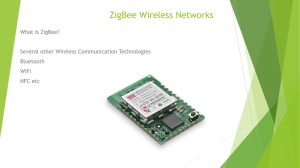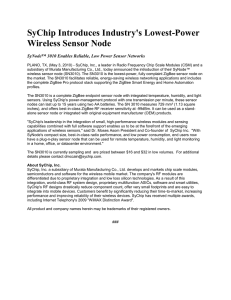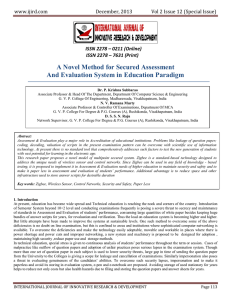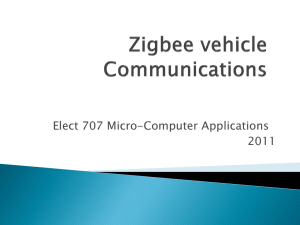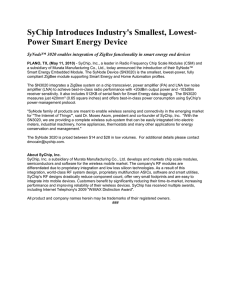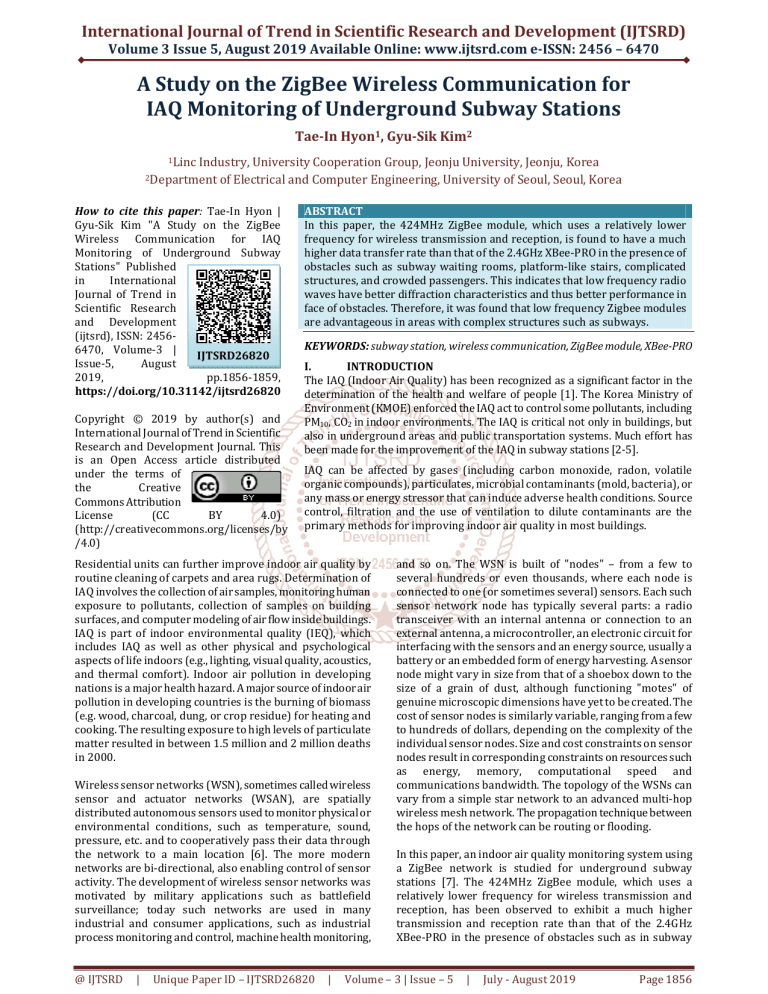
International Journal of Trend in Scientific Research and Development (IJTSRD)
Volume 3 Issue 5, August 2019 Available Online: www.ijtsrd.com e-ISSN: 2456 – 6470
A Study on the ZigBee Wireless Communication for
IAQ Monitoring of Underground Subway Stations
Tae-In Hyon1, Gyu-Sik Kim2
1Linc
Industry, University Cooperation Group, Jeonju University, Jeonju, Korea
of Electrical and Computer Engineering, University of Seoul, Seoul, Korea
2Department
How to cite this paper: Tae-In Hyon |
Gyu-Sik Kim "A Study on the ZigBee
Wireless Communication for IAQ
Monitoring of Underground Subway
Stations" Published
in
International
Journal of Trend in
Scientific Research
and Development
(ijtsrd), ISSN: 24566470, Volume-3 |
IJTSRD26820
Issue-5,
August
2019,
pp.1856-1859,
https://doi.org/10.31142/ijtsrd26820
Copyright © 2019 by author(s) and
International Journal of Trend in Scientific
Research and Development Journal. This
is an Open Access article distributed
under the terms of
the
Creative
Commons Attribution
License
(CC
BY
4.0)
(http://creativecommons.org/licenses/by
/4.0)
ABSTRACT
In this paper, the 424MHz ZigBee module, which uses a relatively lower
frequency for wireless transmission and reception, is found to have a much
higher data transfer rate than that of the 2.4GHz XBee-PRO in the presence of
obstacles such as subway waiting rooms, platform-like stairs, complicated
structures, and crowded passengers. This indicates that low frequency radio
waves have better diffraction characteristics and thus better performance in
face of obstacles. Therefore, it was found that low frequency Zigbee modules
are advantageous in areas with complex structures such as subways.
KEYWORDS: subway station, wireless communication, ZigBee module, XBee-PRO
I.
INTRODUCTION
The IAQ (Indoor Air Quality) has been recognized as a significant factor in the
determination of the health and welfare of people [1]. The Korea Ministry of
Environment (KMOE) enforced the IAQ act to control some pollutants, including
PM10, CO2 in indoor environments. The IAQ is critical not only in buildings, but
also in underground areas and public transportation systems. Much effort has
been made for the improvement of the IAQ in subway stations [2-5].
IAQ can be affected by gases (including carbon monoxide, radon, volatile
organic compounds), particulates, microbial contaminants (mold, bacteria), or
any mass or energy stressor that can induce adverse health conditions. Source
control, filtration and the use of ventilation to dilute contaminants are the
primary methods for improving indoor air quality in most buildings.
Residential units can further improve indoor air quality by
routine cleaning of carpets and area rugs. Determination of
IAQ involves the collection of air samples, monitoring human
exposure to pollutants, collection of samples on building
surfaces, and computer modeling of air flow inside buildings.
IAQ is part of indoor environmental quality (IEQ), which
includes IAQ as well as other physical and psychological
aspects of life indoors (e.g., lighting, visual quality, acoustics,
and thermal comfort). Indoor air pollution in developing
nations is a major health hazard. A major source of indoor air
pollution in developing countries is the burning of biomass
(e.g. wood, charcoal, dung, or crop residue) for heating and
cooking. The resulting exposure to high levels of particulate
matter resulted in between 1.5 million and 2 million deaths
in 2000.
Wireless sensor networks (WSN), sometimes called wireless
sensor and actuator networks (WSAN), are spatially
distributed autonomous sensors used to monitor physical or
environmental conditions, such as temperature, sound,
pressure, etc. and to cooperatively pass their data through
the network to a main location [6]. The more modern
networks are bi-directional, also enabling control of sensor
activity. The development of wireless sensor networks was
motivated by military applications such as battlefield
surveillance; today such networks are used in many
industrial and consumer applications, such as industrial
process monitoring and control, machine health monitoring,
@ IJTSRD
|
Unique Paper ID – IJTSRD26820
|
and so on. The WSN is built of "nodes" – from a few to
several hundreds or even thousands, where each node is
connected to one (or sometimes several) sensors. Each such
sensor network node has typically several parts: a radio
transceiver with an internal antenna or connection to an
external antenna, a microcontroller, an electronic circuit for
interfacing with the sensors and an energy source, usually a
battery or an embedded form of energy harvesting. A sensor
node might vary in size from that of a shoebox down to the
size of a grain of dust, although functioning "motes" of
genuine microscopic dimensions have yet to be created. The
cost of sensor nodes is similarly variable, ranging from a few
to hundreds of dollars, depending on the complexity of the
individual sensor nodes. Size and cost constraints on sensor
nodes result in corresponding constraints on resources such
as energy, memory, computational speed and
communications bandwidth. The topology of the WSNs can
vary from a simple star network to an advanced multi-hop
wireless mesh network. The propagation technique between
the hops of the network can be routing or flooding.
In this paper, an indoor air quality monitoring system using
a ZigBee network is studied for underground subway
stations [7]. The 424MHz ZigBee module, which uses a
relatively lower frequency for wireless transmission and
reception, has been observed to exhibit a much higher
transmission and reception rate than that of the 2.4GHz
XBee-PRO in the presence of obstacles such as in subway
Volume – 3 | Issue – 5
|
July - August 2019
Page 1856
International Journal of Trend in Scientific Research and Development (IJTSRD) @ www.ijtsrd.com eISSN: 2456-6470
waiting rooms, platform stairs, complicated structures, and
crowded passengers. This indicates that the lower frequency
radio waves have better diffraction characteristics and thus
have better performance when obstructed by obstacles.
Therefore, it was found that the low frequency Zigbee
modules are advantageous in complex structures such as
subways.
II.
IAQ Monitoring Using a ZigBee Network
2.1 ZigBee network:
ZigBee is a low-cost, low-power, wireless mesh network
standard targeted at the wide development of long battery
life devices in wireless control and monitoring applications.
Zigbee devices have low latency, which further reduces
average current. ZigBee chips are typically integrated with
radios and with microcontrollers that have between 60256 KB of flash memory. ZigBee operates in the industrial,
scientific and medical (ISM) radio bands: 2.4 GHz in most
jurisdictions worldwide; 784 MHz in China, 868 MHz in
Europe and 915 MHz in the USA and Australia. Data rates
vary from 20 kbit/s (868 MHz band) to 250 kbit/s (2.4 GHz
band). The ZigBee network layer natively supports both star
and tree networks, and generic mesh networking. Every
network must have one coordinator device, tasked with its
creation, the control of its parameters and basic
maintenance. Within star networks, the coordinator must be
the central node. Both trees and meshes allow the use of
ZigBee routers to extend communication at the network
level. ZigBee builds on the physical layer and media access
control defined in IEEE standard 802.15.4 for low-rate
WPANs. The specification includes four additional key
components: network layer, application layer, ZigBee device
objects (ZDOs) and manufacturer-defined application objects
which allow for customization and favor total integration.
ZDOs are responsible for some tasks, including keeping track
of device roles, managing requests to join a network, as well
as device discovery and security. ZigBee is one of the global
standards of communication protocol formulated by the
significant task force under the IEEE 802.15 working group.
The fourth in the series, WPAN Low Rate/ZigBee is the
newest and provides specifications for devices that have low
data rates, consume very low power and are thus
characterized by long battery life. Other standards like
Bluetooth and IrDA address high data rate applications such
as voice, video and LAN communications.
ZigBee supports several network topologies; however, the
most commonly used configurations are star, mesh and
cluster tree topologies as shown in Fig. 1. In a star topology,
the network consists of one coordinator which is responsible
for initiating and managing the devices over the network. All
other devices are called end devices that directly
communicate with coordinator. This is used in industries
where all the end point devices are needed to communicate
with the central controller, and this topology is simple and
easy to deploy. In mesh and tree topologies, the ZigBee
network is extended with several routers where coordinator
is responsible for initiating them. These structures allow any
device to communicate with any other adjacent node for
providing redundancy to the data. If any node fails, the
information is routed automatically to other device by these
topologies. As the redundancy is the main factor in
industries, hence mesh topology is mostly used. In a clustertree network, each cluster consists of a coordinator with leaf
nodes, and these coordinators are connected to parent
@ IJTSRD
|
Unique Paper ID – IJTSRD26820
|
coordinator which initiates the entire network. Due to the
advantages of ZigBee technology like low cost and low
power operating modes and its topologies, this short range
communication technology is best suited for several
applications
compared
to
other
proprietary
communications, such as Bluetooth, Wi-Fi, etc.
Fig.1. ZigBee topologies
2.2 Implementation of ZigBee module:
Digi XBee and Digi XBee-PRO ZigBee RF modules provide
cost effective wireless connectivity to electronic devices [8].
They are interoperable with other ZigBee PRO feature set
devices, including devices from other vendors. Digi ZigBee
Development Kits are useful in facilitating ZigBee application
development. Digi XBee and Digi XBee-PRO ZigBee modules
are ideal for applications in the energy and controls markets
where manufacturing efficiencies are critical. The Serial
Peripheral Interface (SPI) provides a high-speed interface
and optimizes integration with embedded microcontrollers,
lowering development costs and reducing time to market.
Products in the Digi XBee family require little to no
configuration or additional development. Programmable
versions of the Digi XBee and Digi XBee-PRO ZigBee module
make customizing applications easy. Programming directly
on the module eliminates the need for a separate processor.
Because the wireless software is isolated, applications can be
developed with no risk to RF performance or security. Digi’s
ZigBee compatible module is based on the Ember EM35x
(EM357 and EM3587) system on chip (SoC) radio ICs from
SiliconLabs, utilizing 32-bit ARM CortexTM M3 processor.
The S2D EM3587 version has a larger memory footprint for
customers who may want to upgrade to Thread, an IPv6
based networking stack. Fig. 2 shows ZCM(ZigBee
coordinator modem) and ZED(ZigBee end device) developed
for ZigBee network.
Fig.2 left: ZCM(ZigBee coordinator modem), right :
ZED(ZigBee end device)
Wireless transceiver modules for the 424 MHz and 2.4 GHz
ISM bands, as shown in Fig. 3, are used in industrial,
scientific and medical devices, and their transmit power is
Volume – 3 | Issue – 5
|
July - August 2019
Page 1857
International Journal of Trend in Scientific Research and Development (IJTSRD) @ www.ijtsrd.com eISSN: 2456-6470
limited to less than 10 mW. In this study, we want to identify
the more suitable frequency between 2.4 GHz and 424 MHz
in the underground environment for the reliable
transmission of sensor data in the wireless section of the
network and apply it to the underground environment
detection system. To understand the characteristics of the
424 MHz and 2.4 GHz wireless transceiver modules,
Copaland's UM-12K (424 MHz) and Digi's XBee-PRO (2.4
GHz) were selected and compared.
obstacles, and the second is the transmission throughput at a
distance of 55 meters bent in the presence of an obstacle in
the middle, and lastly the transmission throughput at a point
20 meters down the stairs.
Table1. Data transfer rate of Zigbee module (test 1)
Test point 2.4GHz ( 10 mW ) 424MHz ( 10 mW )
1
95%
99%
2
53%
96%
3
0%
79%
Fig.3. Wireless transmit / receive module, Copaland's
UM-12K (424 MHz, left) and Digi's XBee-PRO (2.4 GHz,
right)
Copaland's UM-12K is a subminiature product that enables
bi-directional data communication through RS-232 protocol
communication that can be widely applied to wireless meter
reading, remote control, field monitoring, and data
transmission.The module's wireless modem has its own CPU
and protocol built-in, so that data can be transmitted
bidirectionally between modems without any special
operation. Data transmission between the module and the
computer can be easily carried out by wired (UART, RS-232)
communication. In order to confirm the frequency suitable
for the wireless data transmission of the underground
environment detection system, the experiment environment
was structured as shown in Fig. 4 and Fig. 5 using Copaland's
424 MHz wireless transceiver module and Digi's 2.4 GHz
wireless transceiver module, respectively.
Fig.6. Waiting room in a subway station
As can be seen from Table 1, the 424 MHz ZigBee module
performs better in all cases than the 2.4 GHz ZigBee module,
especially in spaces with obstacles, bends, or stairways. This
is judged to be because of the lower operating frequency
enabling superior diffraction of the radio wave.
Secondly, the experimental results of fixing the receiver to
the narrow and crowded subway platform as shown in Fig. 7
and moving the transmitter around are shown in Table 2.
Fig.4. 2.4 GHz experimental module configuration
Fig.5. 424 MHz experimental module configuration
2.3 Experimental study in a subway station:
First, the performance test of wireless data transmission of
2.4 GHz and 424 MHz Zigbee modules was performed in the
subway waiting room as shown in Fig. 6. Table 1 shows the
results of the experiment of fixing the receiver in one waiting
room and moving the transmitter around. At each location,
the transmitter sent data 100 times and by measuring the
number of ACK signals received from the receiver the data
rate was determined. The first test result is the successful
transmission rate at a point 45 meters away without
@ IJTSRD
|
Unique Paper ID – IJTSRD26820
|
Fig.7. Crowded platform in a subway station
Again, at each location, the transmitter sent the data 100
times and received the ACK signal from the receiver to
determine the data transfer throughput. The first test result
is the data throughput at a straight line distance of 35m with
an obstacle in the middle, and the other three cases likewise
the throughputs at a straight line distance of 65m, 105m, and
Volume – 3 | Issue – 5
|
July - August 2019
Page 1858
International Journal of Trend in Scientific Research and Development (IJTSRD) @ www.ijtsrd.com eISSN: 2456-6470
160m with an obstacle in the middle. As can be seen from the
results in Table 2, on the narrow and crowded subway
platform, the 2.4 GHz XBee-PRO is unable to produce any
throughput at a distance of more than 35m in a straight line.
The 424MHz ZigBee module, however, consistently
outperforms the 2.4GHz XBee-PRO even though the data
throughputs gradually decreased over distance.
The results of Table 1 and Table 2 show that the 424MHz
ZigBee module, which uses a relatively lower frequency for
radio transmission and reception, comparatively has a much
better data throughput when in the presence of obstacles
such as subway waiting rooms, platform stairs, complicated
structures, and crowded passengers.
Table2. Data Transfer Rate of Zigbee Module (test 2)
Distance 2.4GHz ( 10 mW ) 424MHz ( 10 mW )
35m
0%
91%
65m
0%
55%
105m
0%
26%
160m
0%
0%
Concluding Remarks
III.
In order to implement an air quality monitoring system
based on environmental sensors for the waiting room or the
platform of an underground subway station, wireless sensor
network systems are essential. In this paper, ZigBee modules
are implemented in the sensor network system and are
studied to evaluate the performance of the wireless
communication for sending and receiving of measured
sensor data. Experimental results show that in the presence
of mixed obstacles such as subway waiting room, platform
stairs, complicated structure, and crowded passengers, the
424MHz ZigBee module, which has a relatively lower
frequency of radio transmission and reception, has a much
higher data throughput than XBee-PRO of 2.4GHz. This
indicates that the lower frequency radio waves have better
diffraction characteristics and thus better performance when
obstructed by obstacles. Therefore, it was found that low
frequency Zigbee modules are advantageous in complex
structures such as subways.
@ IJTSRD
|
Unique Paper ID – IJTSRD26820
|
Acknowledgment
This work was supported by the 2019 Research Fund of the
University of Seoul
References
[1] http://www.euro.who.int/__data/assets/pdf_file/0009
/128169/e94535.pdf
[2] Jihan Song, Heekwan Lee, Shin-Do Kim, and Dong-Sool
Kim, "How about the IAQ in subway environment and
its management," Asian Journal of Atmospheric
Environment, vol.2, no.1, pp.60-67, June, 2008
[3] Youn-Suk Son, Young-Hoon Kang, Sang-Gwi Chung,
Hyun Ju Park, and Jo-Chun Kim, "Efficiency evaluation
of adsorbents for the removal of VOC and NO2 in an
underground subway station," Asian Journal of
Atmospheric Environment, vol.5, no.2, pp.113-120, June,
2011
[4] Kyung Jin Ryu, MakhsudaJuraeva, Sang-Hyun Jeong,
and Dong Joo Song, "Ventilation efficiency in the
subway environment for the indoor air quality," World
Academy of Science, Engineering and Technology, vol.63,
pp.34-38, March, 2012
[5] Youn-Suk Son, Trieu-Vuong Dinh, Sang-Gwi Chung, Jaihyo Lee, and Jo-Chun Kim, "Removal of particulate
matter emitted from a subway tunnel using magnetic
filters," Environmental Science & Technology, vol.48,
pp.2870-2876, Feb., 2014
[6] Jae-Woo Nam, Hyun-Tae Kim, Byeong-Bin Min, KwangHo Kim, Gyu-Sik Kim, and Jo-Chun Kim, "Ventilation
control of subway station using USN environmental
sensor monitoring system", 2011 International
Conference on Control, Automation and Systems,
Oct.26-29, pp.305-308, 2011
[7] Gyu-Sik Kim, Youn-Suk Son, Jai-Hyo Lee, In-Won Kim,
Jo-Chun Kim, Joon-Tae Oh and HieSik Kim, "Air
pollution monitoring and control system for subway
stations using environmental sensors," Journal of
Sensors, pp.1-10, July, 2016
[8] https://www.digi.com/products/xbee-rf-solutions
/embedded-rf-modules-modems/digi-xbee-zigbee
Volume – 3 | Issue – 5
|
July - August 2019
Page 1859


